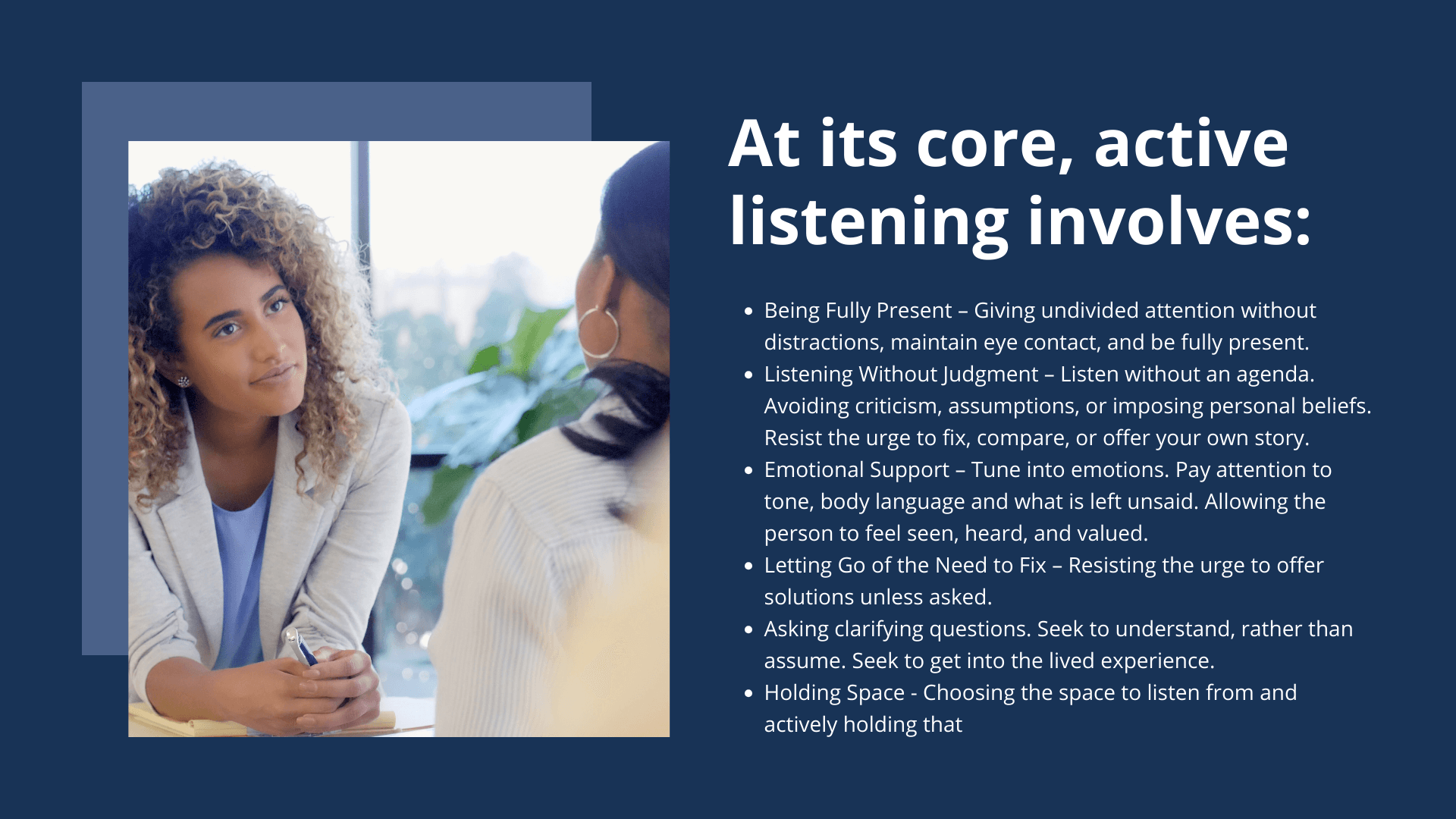When was the last time you felt truly heard? Not judged, fixed, or interrupted but to have somebody just be with you in your experience? To hold space for you while you spoke, without rushing to offer advice or steer the conversation in another direction? To be heard not just for your words, but for the truth behind them?
Nowadays, these moments are rare. We have normalized a type of listening that isn’t really listening at all.
We listen for our turn to speak.
We listen to reply, rather than understand.
We listen to offer solutions while someone is still describing their situation.
We listen through the filter of our own experiences and biases.
We listen to judge, correct, or insert our opinions.
In personal development there is a distinction regarding how people listen to others, you can think of them as filters, often distorted, that we pick up from our experiences as we grow. Everything we already "know to be true" makes up our permanent state of listening. We think we are open-minded, but we listen to people through a wall of our opinions; judging, condemning, wanting to reply, instead of being present to what they are saying. Our pre-existing opinions, stories and judgments hinder genuine understanding. By taking the time to recognize this tendency in ourselves, becoming aware of our filters and pushing them to one side while we listen to others, it allows for more authentic and effective communication.
What we rarely do is listen to learn. To understand. To hold space for someone. To hear them for who they are and what they are going through.
Yet, when you hold space for someone and actively listen when you are fully present with them and their words you create something powerful. This kind of listening allows people to move through grief, gain profound insight, and rediscover meaning in their own words. Simply being heard can be transformative. As leaders, it is integral for us to learn how to listen in this way. Gold drops out of people's mouths when you do.
The 3 biggest listening traps:
The "Me Too" Trap - You relate everything to your own experience.
Example: Someone shares a tough challenge, and instead of fully hearing them, you jump in with, “That happened to me too! Here’s what I did…”
❌ Why it’s a trap: It shifts the focus to you instead of validating them.
Example: Someone shares a tough challenge, and instead of fully hearing them, you jump in with, “That happened to me too! Here’s what I did…”
❌ Why it’s a trap: It shifts the focus to you instead of validating them.
The "Fix It" Trap - You immediately try to solve the problem instead of listening.
Example: A friend vents about their stressful job, and you say, “You should just quit.”
❌ Why it’s a trap: Most people don’t want solutions—they want to feel heard first.
Example: A friend vents about their stressful job, and you say, “You should just quit.”
❌ Why it’s a trap: Most people don’t want solutions—they want to feel heard first.
The "Mind Reader" Trap - You assume you know what they mean without clarifying.
Example: Someone says, “I had a really tough day,” and you assume it’s work-related—but it’s actually personal.
❌ Why it’s a trap: Assumptions lead to misunderstandings and make people feel unheard.
Example: Someone says, “I had a really tough day,” and you assume it’s work-related—but it’s actually personal.
❌ Why it’s a trap: Assumptions lead to misunderstandings and make people feel unheard.
The Power of Active Listening
Active listening is the antidote to the half-hearted, distracted listening that dominates our conversations today. It requires full presence, deep curiosity, and a commitment to understanding the other person's perspective. Listening as an active process that creates the space for speaking and understanding: Listening is the clearing in which speaking can occur; it’s the possibility for understanding, for meaning, for being known and loved. It is to hold space for someone, which means creating an environment of presence, acceptance, and non-judgment where they feel safe to express themselves fully. It’s the act of deeply listening without trying to fix, advise, or control the outcome; allowing the other person to process their emotions, thoughts, or experiences in their own way. It is also an active choice for how you choose to listen to others. You can choose to listen to them through your opinions, e.g., "oh she is arrogant" and when you are in that space, that is all you will hear, but if you actually choose an empowering space to listen from such as, e.g., "gold drops out of her mouth when she speaks" only then will you be open enough to hear the gold.
Unlike passive listening, where we merely hear words and seek to reply, active listening ensures the speaker feels valued, understood, and acknowledged.

How to Practice Active Listening
- Be Present - Silence notifications, put your phone down, and shift your focus entirely to the person speaking. This signals that they have your undivided attention.
- Mirror Back - What You Hear Mirroring means repeating key words or phrases to show you are engaged. If someone says, you’ve been feeling overwhelmed with work lately, you might respond, “Overwhelmed with work?” This simple technique encourages the speaker to go deeper.
- Use Reflective Empathetic Listening - Go beyond just mirroring by paraphrasing what the speaker has said in your own words. For example: Speaker: feel stuck in my job, but I’m scared to make a change. Listener: It sounds like you’re feeling trapped, but also unsure about what comes next. Reflective listening helps the speaker feel truly heard and understood. Listen for the emotions through changes in tone, body language or speed of speaking. Listen for what is not being said, for what lies behind what is said.
- Clarify - Asking open-ended questions to gain deeper insight into the speaker's thoughts and feelings.
- Resist the Urge to Fix - Often, people don’t need solutions they need space to process their thoughts. Instead of jumping in with advice, ask, Do you want feedback, or do you just need to vent?
- Validate Their Experience - Acknowledge their emotions without judgment. Saying things like "That sounds really difficult" or "I can see why you’d feel that way" and create a safe space for honest conversation.
- Notice Biases, Opinions & Judgements - Forming opinions about the speaker or their message prematurely, which can create barriers to understanding. Focusing only on parts of the conversation that align with one's interests or biases. Put these to one side.
- Holding Space - choose an empowering stance to listen from - every morning I choose to listen to people as if "gold drops out of their mouths" and guess what? That is what happens. It is an empowering space for both them and me and it is an active practice.
The Transformative Power of Listening
This type of listening is simple, but not easy. It requires patience, self-awareness, creation and a willingness to set aside your own perspectives. But when you truly listen without interrupting, fixing, or filtering through your own lens you give the other person a rare and precious gift: the feeling of being seen and heard. By practicing these habits, leaders can work towards being more engaged and and having unbiased listening.
In a world where so many people are waiting for their turn to speak, be the person who listens to understand, to learn, to hold space. You might be surprised at how much it changes your relationships, your leadership, and even yourself.


0 Comments